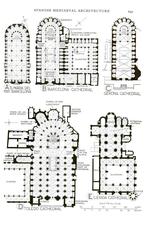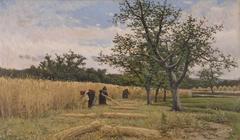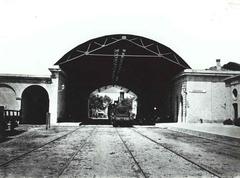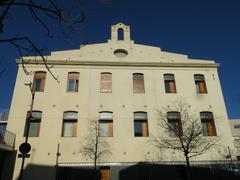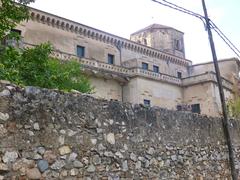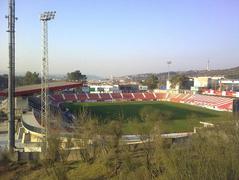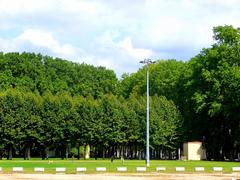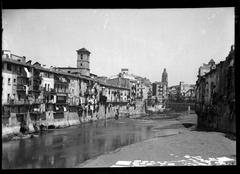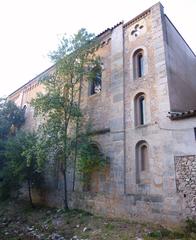Girona Town Hall Visiting Hours, Tickets, and Guide to Girona Historical Sites
Date: 14/06/2025
Introduction
Nestled in the heart of Girona’s historic Old Town, the Girona Town Hall (Ajuntament de Girona) stands as an emblematic monument reflecting the city’s rich political heritage, architectural splendor, and communal spirit. Its architectural fabric weaves together medieval foundations, Renaissance elegance, and neoclassical refinement, complementing iconic landmarks such as the Girona Cathedral and the Jewish Quarter. The Town Hall is not only the seat of the municipal government but also a vibrant hub for major city festivals like Temps de Flors (Flower Festival) and the Sant Narcís Fair. This guide provides a comprehensive overview of Girona Town Hall—from its historical and architectural significance to practical visiting information, event highlights, and nearby attractions. For the latest updates, consult the official resources (Girona Tourist Guide, Town Hall of Girona, Girona City Official).
Table of Contents
- Historical Background of Girona Town Hall
- Architectural Evolution
- Civic and Cultural Significance
- Notable Events & Restoration
- Visiting Information: Hours, Tickets, and Accessibility
- Nearby Attractions
- Festivals and Cultural Events
- Practical Visitor Tips
- Frequently Asked Questions (FAQ)
- Summary and Call to Action
- Sources
Historical Background of Girona Town Hall
Girona Town Hall traces its origins to the medieval era, with the earliest references dating back to the 14th century. Initially, municipal functions were housed in buildings around Plaça del Vi—the city’s main civic square and a crossroads of trade, religious life, and governance. The Town Hall’s strategic location at the confluence of key urban arteries highlights its central role in Girona’s political and social evolution under the Crown of Aragon.
Architectural Evolution
Medieval Foundations and Renaissance Transformations
The building’s core preserves elements of its medieval past, visible in foundational walls and arcaded ground floors. Major Renaissance modifications introduced Catalan Gothic and Renaissance features, including the arched portico facing Plaça del Vi and elegant stonework on the façade. These adaptations reflect Girona’s prosperity and cultural growth during the Renaissance period.
19th and 20th Century Restorations
The 19th century brought neoclassical refinement and expanded administrative spaces. Unifying the façade and adding the city’s coat of arms, these updates symbolized Girona’s civic pride. Restoration campaigns in the 20th century balanced heritage conservation with modern upgrades, ensuring the Town Hall’s status as a protected Bé Cultural d’Interès Local (BCIL) (Wikimedia Commons).
Civic and Cultural Significance
Girona Town Hall serves as the seat of municipal government, the venue for local council meetings, and a gathering place for citizens during festivals, protests, and civic celebrations. The building hosts exhibitions, official receptions, and flag-raising ceremonies, with interiors adorned by art and heraldic emblems narrating Girona’s heritage.
The Town Hall is also deeply woven into the cultural fabric of the city, providing the backdrop for festivals and acting as a catalyst for public engagement, participatory budgeting, and citizen-focused programs (Girona Tourist Guide).
Notable Events & Restoration
Historic Moments
The Town Hall has witnessed key events, from the War of the Spanish Succession and the Peninsular War—where it was a focal point of resistance and negotiation—to the Carlist Wars and the Spanish Civil War, periods during which it hosted critical debates and symbolized Girona’s autonomy.
Recent Developments
Modern restoration projects have enhanced accessibility and preserved the building’s historic integrity. The Town Hall is a highlight on cultural itineraries and guided tours, offering insight into centuries of municipal governance (GPSmyCity).
Visiting Information: Hours, Tickets, and Accessibility
Visiting Hours
- Exterior: Open 24/7; Plaça del Vi is always accessible.
- Interior: Generally accessible only during official events, guided tours, or festivals such as Temps de Flors. Standard administrative hours are Monday–Friday, 9:00 AM–2:00 PM, but interior visits may be restricted. Always check the official website for updated information.
Tickets
- General Access: No tickets required to view the exterior or visit Plaça del Vi.
- Special Events/Tours: Some events or guided tours (especially during festivals) may require tickets. These are available via the Town Hall or local tourist offices (Girona Tourist Guide).
Guided Tours & Accessibility
- Tours: Walking tours of the Old Town frequently include the Town Hall as a highlight, offering historical context and architectural insights.
- Accessibility: The building and plaza are largely accessible, with ramps and adapted facilities. Some cobblestone streets nearby may challenge those with mobility impairments.
Getting There
- Address: Plaça del Vi, 1, 17004 Girona, Spain
- Public Transport: 10–15 minutes’ walk from Girona train station; local buses and taxis available.
- Parking: Public garages nearby, but Old Town is best navigated on foot.
Nearby Attractions
Girona Town Hall’s prime location in the Old Town makes it an ideal base for exploring:
- Girona Cathedral: Renowned for its Romanesque, Gothic, and Baroque elements (Travelsewhere).
- Jewish Quarter (El Call): One of Europe’s best-preserved, with labyrinthine streets (Girona Tourist Guide).
- City Walls: Walk along ancient fortifications for panoramic city views (Arquitectura Catalana).
- Arab Baths: Romanesque structure with Moorish influences.
Festivals and Cultural Events
Girona Town Hall and Plaça del Vi are vibrant centers for major festivals:
Temps de Flors (Flower Festival)
Held annually in mid-May, this festival transforms the Old Town with more than 100 floral installations. Town Hall exhibitions are a highlight, and entry is free (girona-city.com).
Sant Narcís Fairs
Taking place in late October, this celebration of Girona’s patron saint features parades, human towers, concerts, and fireworks. The Town Hall is a focal point for ceremonies and festivities (girona-city.com).
Other Annual Events
- Spring Festival and Legend of Tarlà: Street performances and children’s events.
- Inund’Art Festival: Contemporary art installations and performances.
- Festimams Comedy Festival: Stand-up and theatre shows hosted at the Town Hall theatre (femturisme.cat).
The Town Hall also supports participatory budgeting, civic consultations, and exhibitions, reinforcing its role as a center of community engagement.
Practical Visitor Tips
- When to Visit: Weekday mornings are quieter. Festival periods offer vibrant experiences but larger crowds.
- Photography: The arcaded façade and decorated plaza are best photographed during festivals or in the evening light.
- Amenities: Numerous cafes and restaurants surround Plaça del Vi. Restrooms are available in nearby squares and tourist centers.
- Accessibility: Most areas are pedestrian-friendly, though some Old Town streets are narrow and uneven.
- Language: Catalan is widely spoken; a friendly “Bon dia” is always appreciated.
Frequently Asked Questions (FAQ)
Q: What are the Girona Town Hall visiting hours?
A: The exterior is accessible at all times. Interior visits are generally limited to special events, guided tours, or administrative hours (Mon–Fri, 9:00 AM–2:00 PM).
Q: Are tickets required to visit Girona Town Hall?
A: No tickets are needed for the exterior or Plaça del Vi. Tickets may be necessary for special exhibitions or guided tours.
Q: Is Girona Town Hall accessible for visitors with disabilities?
A: Yes, the building and plaza are largely accessible, but some Old Town streets may pose challenges.
Q: Can I book guided tours?
A: Yes, guided tours of the Old Town and Jewish Quarter, including the Town Hall, can be booked at the tourist information office.
Q: What nearby attractions should I visit?
A: The Cathedral, Jewish Quarter, city walls, and Arab Baths are all within walking distance.
Summary and Call to Action
Girona Town Hall is a cornerstone of the city’s historical, architectural, and cultural landscape. Its medieval roots, Renaissance and neoclassical features, and ongoing civic role make it a must-visit for travelers. Whether you explore its iconic façade, attend a festival, or join a guided tour, the Town Hall is your gateway to Girona’s storied past and vibrant present.
For the latest updates on visiting hours, tickets, and cultural events, consult the official Girona City website or the Girona Tourist Guide. Download the Audiala app for personalized event alerts and visitor tips. Enhance your experience by discovering Girona’s festivals, historic sites, and local cuisine.
